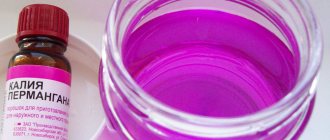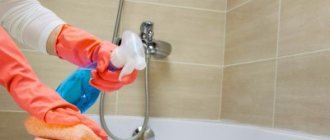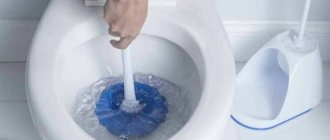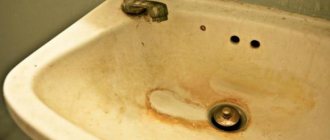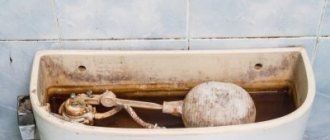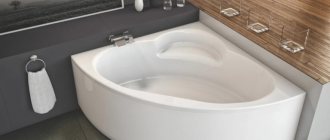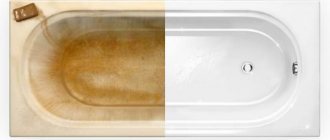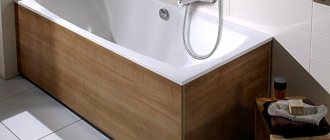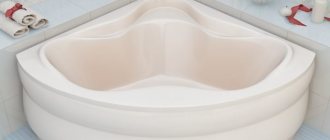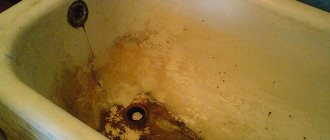If rusty spots or streaks appear on the once snow-white bathtub, do not rush to order restoration of the coating. In most cases, rust stains can be easily removed using the “correct” household products and universal household equipment for cleaning bathroom surfaces.
We tell you how and with what to clean the bathtub from rust deposits without extra effort. In the article we give general and “individual” recommendations for cleaning acrylic, steel and cast iron bathtubs.
Photo credit: moccasinlanding (source – flickr.com)
Chemistry in the fight against rust and limescale
Using ready-made cleaning products is probably the easiest and most trouble-free way to remove stubborn limescale and unpleasant rust stains.
The most effective household chemicals are:
- Domestos.
- Cillit Bang.
- Cif.
- "Pemolux".
- Cleaning gel "Comet".
Use cleaning products strictly in accordance with their instructions for use. It is important to wear gloves when cleaning, rinse thoroughly and ventilate the area after use.
How to use household chemicals
If you can’t get rid of dirt with home remedies, use cleaning powders and gels.
- Read the composition and consider the type of bath.
- It is better to use environmentally friendly substances, but they are more expensive.
- Follow the manufacturer's instructions. For example, sometimes the solution needs to be washed off immediately, sometimes it needs to be left for a while to make the bath clean.
- Some products have a strong, unpleasant odor. This means that to use them, your bathroom must have good ventilation.
- Never clean a bathtub without gloves.
Cleaning using folk remedies at home
Ready-made cleaning products can be replaced with solutions prepared with your own hands at home. Of course, they are unlikely to help get rid of stubborn stains and in order to give the bath a perfect whiteness, you will have to work hard. Despite these minor disadvantages, many housewives give their preference to folk recipes.
Folk remedies are safer for humans and animals. They also do not damage the enamel and are quite economical financially.
The following recipes received the most positive reviews:
Soda
To clean your bathtub you will need:
- soda ash;
- baking soda.
Mode of application:
- Soda ash must be mixed with baking soda in a ratio of 1:1.
- Wet the surface of the bath and apply the resulting mixture.
- Leave the mixture for 25-30 minutes.
- At the end of the time, all you have to do is clean the stains with a sponge dipped in a vinegar solution.
- After all the necessary actions, rinse the bath with boiling water.
Lemon acid
Necessary:
- 3 tbsp. spoons of citric acid;
We apply:
- Dissolve the required amount of acid in 0.5 liters of water (the temperature of the liquid should not be high).
- Using a product with a soft surface, apply the resulting solution to the surface of the bath.
- Leave the bath with the product for half an hour.
- Rinse with water.
Vinegar
Ingredients:
9% acetic acid.
We use:
- Apply the solution to paper napkins.
- Cover the entire surface of the bath with them.
- Leave the bath in this state for 4–5 hours.
- You need to remove any remaining product using a soap solution.
Selecting a Chemical Cleanser
Of course, old, stubborn rust stains are more difficult to remove than fresh ones, so it is important to pay proper attention to cleaning the room in order to keep the body clean. In addition, the material used to manufacture the sanitary ware must be taken into account. Remember that tools and products used to clean, for example, cast iron, can be destructive to acrylic materials.
In many online discussions you can find different advice regarding the use of cleaning products. Best of all, from the point of view of many housewives, the usual liquid powder “Cif”, which can be combined with a dish sponge, copes with rust. “Bref” receives good reviews, which, in addition to effective cleansing, provides a pleasant smell and disinfection.
If all else fails, a more radical solution is needed. It can be represented by a remedy for. We are talking about the yellow bathroom cleaner “W5”. Another option is phosphoric acid, which is found in some cleaning formulations. But it is not recommended to use them too often, as they can create pores in the bathtub, on the damaged surface of which even more dirt will begin to settle.
The last option, also not ideal for more frequent use, is “Savo”.
Expert opinion
Evgenia Taran
Use all products with caution and wear gloves. Particularly strong substances can cause rashes, and Savo even damages the skin.
Cleaning acrylic bathtubs requires compliance with certain rules. The use of abrasives is not recommended. But this material is good with acids. Although you should be careful here too - strong chemicals (solvents) can damage the coating.
When applying any substance, first test the sensitivity of the surface. Apply a little cleaner to an inconspicuous area of the bathtub and evaluate the reaction of the coating. If the rust disappears and the texture and color of the surface does not change, this cleaning product can be used over a large area.
"Mr. Cheester"
This product is intended for cleaning various surfaces - acrylic, metal, ceramic, enameled, etc. It removes plaque (limescale, rust) well and polishes the bathroom due to the acrylic copolymer content.
Expert opinion
Irina Kovtun
Apply the product to the surface covered with rust for 2-3 minutes. Rinse it off.
Delicate cleaning of acrylic coating
Acrylic enamel is a rather fragile coating, so it must be cleaned carefully and using gentle products.
- When cleaning, do not use gasoline or thinner. Cleaning products that contain abrasive elements are also not the best way to remove stains from such a coating. All these substances can damage acrylic enamel and leave scratches in which dirt can become trapped.
- The best way to clean such a surface is to use acids of natural origin. The following recipe is suitable for this:
Apple vinegar
You will need:
- malic and citric acids.
Method of use:
- Run a full bath of warm water.
- Add 1.5 liters of apple cider vinegar and a liter of citric acid to the liquid.
- Stir the water.
- Leave the bath in this state for 12 hours.
- At the end of the time, rinse the bath with boiling water, this will remove any remaining acid on the enamel.
To remove any residual product that did not wash off immediately, you can clean the tub with dish soap.
Cleaning the chrome parts of the bathroom until it shines
In order to wash chrome parts, homemade recipes or ordinary cleaning products are not suitable, otherwise they will lose their shine and become cloudy. To remove stains from parts made of such material, there are special products, one of which is Santekh. You can buy it at any industrial goods store.
It is produced in the form of a spray, which allows you to significantly save on its use. This product does not contain allergens or toxic substances and is safe for people and animals when sprayed.
Cleaning a cast iron bathtub
Despite the abundance of different coatings for bathtubs, cast iron is still found in many homes. But the problem is not what kind of bathtub you have, but how to clean the bathtub from rust and limescale.
Previously, cast iron could be washed with whatever came to hand, and it took much longer than it does now. But at the moment, there are a large number of means to get rid of this problem. Here are the most common ones:
- Dark laundry soap.
- A solution of vinegar and lemon.
- Beer wort.
- Furnace soot.
Basic rules you need to know
Any housewife is not particularly happy if she has to wash away stubborn limescale or rust stains. But all this can be avoided if you follow simple rules that even a child can follow:
- Clean the tub after each use.
- Deep clean your bathroom every week. To do this, treat plumbing fixtures and enamel with special products.
- Be especially careful when choosing a product. Choose the one that best suits your coating.
- When cleaning, do not use metal brushes or abrasives.
By following these simple rules, you will extend the life of your bath for a long time.
Prevention
Any plaque is better washed off fresh. If you regularly remove household dirt, rusty sediment and cleaning with aggressive agents will not threaten your bathtub. To ensure that the problem of rusty plaque bothers you as little as possible, effective preventive measures will help:
- It is advisable to wash the bathtub 2 – 3 times a week with suitable mild products (soda, laundry soap, Cif cream, special care compositions depending on the type of bathtub). Once every week or two, you can clean the bathtub with a gentle acidic cleaner.
- Be sure to repair all leaks. Constantly digging through faulty taps, mixers and shower heads is the cause of rust stains in most cases.
- Avoid stagnation of water at the bottom of the bath - the remaining moisture turns into a brown “path” over time. Modern bathtubs are usually made with a slight slope, along which the water completely goes into the drain. If the surface is perfectly parallel to the floor and the required slope was not created during installation, the water will have to be regularly removed with a rag or towel. Another place where water stagnates is the area around the drain. It should also dry well.
- It is important to monitor the permeability of sewer drains: contact with slowly draining water additionally provokes rust.
- Use special bath polishes. They create a protective film on the surface and ensure cleanliness for several days. Polish can help out if the water in the house is turned off, and after the supply is restored, rusty water flows from the taps for several hours.
Anti-plaque conditioner Ravak Anticalc. - You cannot leave metal objects (basins, hairpins, scissors, etc.) on the bathtub.
Rusty mark from a bucket on the bathroom. - After each use, it is advisable to rinse the bathtub with cold water: rust often flows from hot water pipes, since at high temperatures hardness salts are formed faster and in larger quantities.
- The bath should not remain wet for long. After using the bath, the surface should be wiped dry with moisture-absorbing wipes. This recommendation becomes the rule if the house has old water supply or water with a high iron content.
- Enameled bathtubs can rust not only inside, but also outside. Therefore, all leaks must also be excluded under the bathtub, and the outer surface and visible areas around it must be regularly inspected.
- In order for the room to dry quickly, proper ventilation and good ventilation are required. If the rust turns out to be invincible and it is impossible to return the bathtub to cleanliness, the only way out is to restore or replace the bathtub.
Note: If rusty and cloudy water constantly flows from the tap, all preventive measures will be ineffective: it is necessary to seek a solution to the problem at the level of service organizations. To do this, you must contact the emergency dispatch service with a corresponding application (preferably in writing) and be sure to make sure it is registered. An employee of the organization must establish on the spot the fact of water supply of inadequate quality and draw up a report. You can take a water sample yourself and contact the Sanitary and Epidemiological Station (Rospotrebnadzor) for a paid examination. If poor water quality is confirmed, an application is filed with the court. According to the court decision, the water utility will be obliged to ensure normal water quality, reimburse the costs of the examination and recalculate payments for water supply. This is in theory, in practice everything can take a long time, so you need to draw up collective complaints.
Advice! If you need bathroom renovation specialists, there is a very convenient service for selecting specialists from PROFI.RU. Just fill out the order details, the experts will respond and you can choose who to collaborate with. Each specialist in the system has a rating, reviews and examples of work, which will help with the choice. Looks like a mini tender. Placing an application is FREE and does not oblige you to anything. Works in almost all cities of Russia.
If you are a master, follow this link, register in the system and be able to accept orders.
Important Tips
You already know the basic cleaning methods, but a few tips will still be useful:
- When washing bathtubs and sanitary fittings, use only a sponge or brush with a soft surface, because a hard surface may leave scratches. Dirt will get stuck in the scratches, which you are unlikely to be able to wash off.
- For the same reason, it is prohibited to use abrasive cleaning products.
- Under no circumstances leave metal products on the sides of the bathtub. Metal tends to oxidize when interacting with water, which will lead to the appearance of rust stains.
Now, knowing all the subtleties of cleaning, you can easily wash any stains on enamel at home. To do this, you will spend mere pennies, but you can quickly and efficiently clean the bathtub from rust and plaque.
Features of cleaning surfaces made of different materials
Methods and products that are ideal for enameled cast iron can destroy acrylic. And vice versa.
You should always take into account the characteristics of the material you are going to clean.
- Acrylic. Polymer material (polymethyl methacrylate). Special products are produced for the care of acrylic bathtubs. Acrylic is quite gentle and does not tolerate the use of concentrated alkalis, acids, ammonia, chlorine, and acetone. They leave stains and dull the surface. Also, do not clean the material with metal sponges or hard abrasives. Acrylic is scratched.
- Enamel. Glassy mass, resistant to chemical attack. Theoretically, enamel baths can be cleaned with bleach, acids and alkalis. But in practice, enamel is often damaged by caustic substances - it becomes rough and porous. Enamel is more difficult to scratch than acrylic. It can be cleaned with brushes and soft abrasives.
It is recommended to do some testing before using a new rust remover. Apply the mixture to an inconspicuous place (for example, the edge of a side wall), leave for 15 minutes and rub.
If there are scratches on the surface and the gloss will come off, the bath cleaner is not suitable. Leave it for cleaning the toilet, and choose a different composition for the bathroom.
